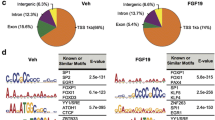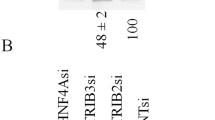Abstract
Purpose
Farnesoid X receptor (Fxr) is a ligand-activated nuclear receptor critical for liver function. Reports indicate that the functions of Fxr in the liver may overlap with those of hepatocyte nuclear factor 4α (Hnf4α), but studies of their precise genome-wide interaction to regulate gene transcription in the liver are lacking. Thus, we compared the genome-wide binding of Fxr and Hnf4α in the liver of mice and characterized their cooperative activity on binding to and activating target gene transcription.
Methods
Genome-wide ChIP-Seq data of Fxr and Hnf4α in mouse liver were analyzed by MACS, BEDTools, and DAVID. Co-immunoprecipitation, ChIP-qPCR, and luciferase assays were done to test for protein-protein interaction and cooperative binding.
Results
ChIP-seq analysis showed nearly 50% binding sites of Fxr and Hnf4α in mouse liver overlap and Hnf4α bound to shared target sites upstream and in close proximity to Fxr. Moreover, genes co-bound by Fxr and Hnf4α are enriched in complement and coagulation cascades and drug metabolism. A direct Fxr-Hnf4α protein interaction dependent on Fxr activity was detected and transcriptional assays suggest that Hnf4α can increase Fxr transcriptional activity. Conversely, binding assays showed Hnf4α can be either Fxr-dependent or -independent at different shared binding sites.
Conclusion
Our results showed that Fxr cooperates with Hnf4α in the liver to modulate gene transcription. This study provides the first evidence on a genome-wide scale of both cooperative and independent interactions between Fxr and Hnf4α in regulating gene transcription in the liver.





Similar content being viewed by others
Abbreviations
- ApoC-III:
-
apolipoprotein C-III
- CA:
-
cholic acid
- ChIP-qPCR:
-
chromatin immunoprecipitation followed by quantitative polymerase chain reaction
- ChIP-Seq:
-
chromatin immunoprecipitation followed by massively parallel sequencing
- Co-IP:
-
co-immunoprecipitation
- Cyp7a1:
-
cholesterol 7 alpha-hydroxylase
- DR-1:
-
direct hexanucleotide repeat separated by 1 nucleotide
- FXR/Fxr:
-
farnesoid X receptor
- HNF4α/Hnf4α:
-
hepatocyte nuclear factor 4 alpha
- IR-1:
-
inverted hexanucleotide repeat separated by 1 nucleotide
- KO:
-
knockout
- RXRα:
-
retinoid x receptor alpha
- Shp:
-
small heterodimer partner
- Sr-b1:
-
scavenger receptor class B type 1
- TSS:
-
transcriptional start site
REFERENCES
Parks DJ, Blanchard SG, Bledsoe RK, Chandra G, Consler TG, et al. Bile acids: natural ligands for an orphan nuclear receptor. Science. 1999;284:1365–8.
Makishima M, Okamoto AY, Repa JJ, Tu H, Learned RM, et al. Identification of a nuclear receptor for bile acids. Science. 1999;284:1362–5.
Wang H, Chen J, Hollister K, Sowers LC, Forman BM. Endogenous bile acids are ligands for the nuclear receptor Fxr/Bar. Mol Cell. 1999;3:543–53.
Seol W, Choi HS, Moore DD. Isolation of proteins that interact specifically with the retinoid X receptor: two novel orphan receptors. Mol Endocrinol. 1995;9:72–85.
Sinal CJ, Tohkin M, Miyata M, Ward JM, Lambert G, et al. Targeted disruption of the nuclear receptor Fxr/Bar impairs bile acid and lipid homeostasis. Cell. 2000;102:731–44.
Kok T, Hulzebos CV, Wolters H, Havinga R, Agellon LB, et al. Enterohepatic circulation of bile salts in farnesoid X receptor-deficient mice. J Biol Chem. 2003;278:41930–7.
Chen WS, Manova K, Weinstein DC, Duncan SA, Plump AS, et al. Disruption of the Hnf-4 gene, expressed in visceral endoderm, leads to cell death in embryonic ectoderm and impaired gastrulation of mouse embryos. Genes Dev. 1994;8:2466–77.
Inoue Y, Yu AM, Yim SH, Ma X, Krausz KW, et al. Regulation of bile acid biosynthesis by hepatocyte nuclear factor 4alpha. J Lipid Res. 2006;47:215–27.
Inoue Y, Yu AM, Inoue J, Gonzalez FJ. Hepatocyte nuclear factor 4alpha is a central regulator of bile acid conjugation. J Biol Chem. 2004;279:2480–9.
Claudel T, Inoue Y, Barbier O, Duran-Sandoval D, Kosykh V, et al. Farnesoid X receptor agonists suppress hepatic apolipoprotein Ciii expression. Gastroenterology. 2003;125:544–55.
Shih DQ, Dansky HM, Fleisher M, Assmann G, Fajans SS, et al. Genotype/phenotype relationships in Hnf-4alpha/Mody1: haploinsufficiency is associated with reduced apolipoprotein (Aii), apolipoprotein (Ciii), lipoprotein (a), and triglyceride levels. Diabetes. 2000;49:832–7.
Stroup D, Chiang JY. Hnf4 and Coup-Tfii interact to modulate transcription of the cholesterol 7alpha-hydroxylase gene (Cyp7a1). J Lipid Res. 2000;41:1–11.
Tirona RG, Lee W, Leake BF, Lan LB, Cline CB, et al. The orphan nuclear receptor Hnf4alpha determines Pxr- and car-mediated xenobiotic induction of Cyp3a4. Nat Med. 2003;9:220–4.
Zhang Y, Lee FY, Barrera G, Lee H, Vales C, et al. Activation of the nuclear receptor Fxr improves hyperglycemia and hyperlipidemia in diabetic mice. Proc Natl Acad Sci U S A. 2006;103:1006–11.
Watanabe M, Houten SM, Wang L, Moschetta A, Mangelsdorf DJ, et al. Bile acids lower triglyceride levels via a pathway involving Fxr, Shp, and Srebp-1c. J Clin Invest. 2004;113:1408–18.
Staels B, Kuipers F. Bile acid sequestrants and the treatment of type 2 diabetes mellitus. Drugs. 2007;67:1383–92.
Cariou B, van Harmelen K, Duran-Sandoval D, van Dijk TH, Grefhorst A, et al. The farnesoid X receptor modulates adiposity and peripheral insulin sensitivity in mice. J Biol Chem. 2006;281:11039–49.
Ma K, Saha PK, Chan L, Moore DD. Farnesoid X receptor is essential for normal glucose homeostasis. J Clin Invest. 2006;116:1102–9.
Maran RR, Thomas A, Roth M, Sheng Z, Esterly N, et al. Fxr deficiency in mice leads to increased intestinal epithelial cell proliferation and tumor development. J Pharmacol Exp Ther. 2009;328:469-77.
Modica S, Murzilli S, Salvatore L, Schmidt DR, Moschetta A. Nuclear bile acid receptor Fxr protects against intestinal tumorigenesis. Cancer Res. 2008;68:9589–94.
Kim I, Morimura K, Shah Y, Yang Q, Ward JM, et al. Spontaneous hepatocarcinogenesis in farnesoid X receptor-null mice. Carcinogenesis. 2007;28:940–6.
Yang F, Huang X, Yi T, Yen Y, Moore DD, et al. Spontaneous development of liver tumors in the absence of the bile acid receptor farnesoid X receptor. Cancer Res. 2007;67:863–7.
Thomas AM, Hart SN, Kong B, Fang J, Zhong XB, et al. Genome-wide tissue-specific farnesoid X receptor binding in mouse liver and intestine. Hepatology. 2010;51:1410–9.
Chong HK, Infante AM, Seo Y-K, Jeon T-I, Zhang Y, et al. Genome-wide interrogation of hepatic Fxr reveals an asymmetric Ir-1 motif and synergy with Lrh-1. Nucleic Acids Res. 2010;38:6007–17.
Gonzalez FJ. Regulation of hepatocyte nuclear factor 4 alpha-mediated transcription. Drug Metab Pharmacokinet. 2008;23:2–7.
Maloney PR, Parks DJ, Haffner CD, Fivush AM, Chandra G, et al. Identification of a chemical tool for the orphan nuclear receptor Fxr. J Med Chem. 2000;43:2971–4.
Hayhurst GP, Lee YH, Lambert G, Ward JM, Gonzalez FJ. Hepatocyte nuclear factor 4alpha (nuclear receptor 2a1) is essential for maintenance of hepatic gene expression and lipid homeostasis. Mol Cell Biol. 2001;21:1393–403.
Schmidt D, Wilson MD, Ballester B, Schwalie PC, Brown GD, et al. Five-vertebrate Chip-Seq reveals the evolutionary dynamics of transcription factor binding. Science. 2010;328:1036–40.
Zhang Y, Liu T, Meyer CA, Eeckhoute J, Johnson DS, et al. Model-based analysis of Chip-Seq (Macs). Genome Biol. 2008;9:R137.
Quinlan AR, Hall IM. Bedtools: a flexible suite of utilities for comparing genomic features. Bioinformatics. 2010;26:841–2.
Kent WJ, Sugnet CW, Furey TS, Roskin KM, Pringle TH, et al. The human genome browser at UCSC. Genome Res. 2002;12:996–1006.
Dennis Jr G, Sherman BT, Hosack DA, Yang J, Gao W, et al. David: database for annotation, visualization, and integrated discovery. Genome Biol. 2003;4:P3.
Li G, Thomas AM, Hart SN, Zhong X, Wu D, et al. Farnesoid X receptor activation mediates head-to-tail chromatin looping in the Nr0b2 gene encoding small heterodimer partner. Mol Endocrinol. 2010;24:1404–12.
Li G, Thomas AM, Williams JA, Kong B, Liu J, et al. Farnesoid X receptor induces murine scavenger receptor class B type I via intron binding. PLoS One. 2012;7:e35895.
Williams JA, Thomas AM, Li G, Kong B, Zhan L, et al. Tissue specific induction of P62/Sqstm1 by farnesoid X receptor. PLoS One. 2012;7:e43961.
Huber RM, Murphy K, Miao B, Link JR, Cunningham MR, et al. Generation of multiple farnesoid-X-receptor isoforms through the use of alternative promoters. Gene. 2002;290:35–43.
Li T, Chiang JY. Rifampicin induction of Cyp3a4 requires pregnane X receptor cross talk with hepatocyte nuclear factor 4alpha and coactivators, and suppression of small heterodimer partner gene expression. Drug Metab Dispos. 2006;34:756–64.
Podvinec M, Kaufmann MR, Handschin C, Meyer UA. Nubiscan, an in silico approach for prediction of nuclear receptor response elements. Mol Endocrinol. 2002;16:1269–79.
Sladek FM, Zhong WM, Lai E, Darnell Jr JE. Liver-enriched transcription factor Hnf-4 is a novel member of the steroid hormone receptor superfamily. Genes Dev. 1990;4:2353–65.
Bolotin E, Schnabl JM, Sladek FM, in Yusuf D et al. Hnf4a: the transcription factor encyclopedia. Genome Biol. 2012;13:R24.
Modica S, Gadaleta RM, Moschetta A. Deciphering the nuclear bile acid receptor Fxr paradigm. Nucl Recept Signal. 2010;8:e005.
Hurtado A, Holmes KA, Ross-Innes CS, Schmidt D, Carroll JS. Foxa1 is a key determinant of estrogen receptor function and endocrine response. Nat Genet. 2011;43:27–33.
Lupien M, Eeckhoute J, Meyer CA, Wang Q, Zhang Y, et al. Foxa1 translates epigenetic signatures into enhancer-driven lineage-specific transcription. Cell. 2008;132:958–70.
ACKNOWLEDGMENTS AND DISCLOSURES
This work was supported by CPRIT Training Grants RP101502 to The University of Texas MD Anderson Cancer Center (AMT), DK031343 (GLG), DK090036 (GLG), and a Madison and Lila Self Graduate Fellowship from the University of Kansas (SNH).
Author information
Authors and Affiliations
Corresponding author
Electronic supplementary material
Below is the link to the electronic supplementary material.
Supplemental Table I
(DOC 34 kb)
Supplemental Table II
(DOC 28 kb)
Supplemental Figure 1
(DOCX 28 kb)
Rights and permissions
About this article
Cite this article
Thomas, A.M., Hart, S.N., Li, G. et al. Hepatocyte Nuclear Factor 4 Alpha and Farnesoid X Receptor Co-regulates Gene Transcription in Mouse Livers on a Genome-Wide Scale. Pharm Res 30, 2188–2198 (2013). https://doi.org/10.1007/s11095-013-1006-7
Received:
Accepted:
Published:
Issue Date:
DOI: https://doi.org/10.1007/s11095-013-1006-7




